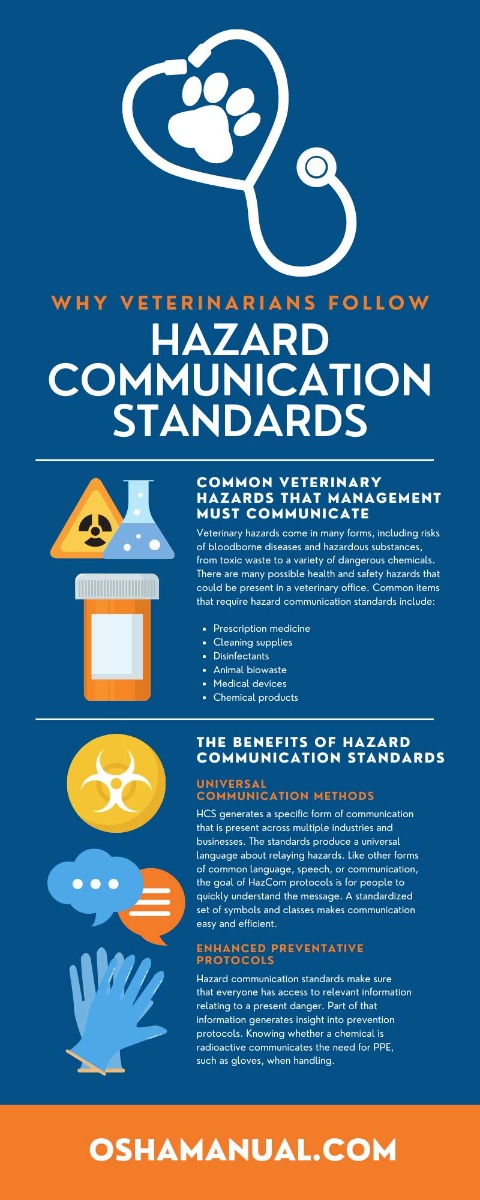
Furry friends, four-legged companions, and many other types of adorable family members stay happy and healthy because of the care of veterinary professionals. From surgeries to general checkups, vet clinics provide all kinds of life-saving services for pets. On top of taking care of animals, veterinary staff also work hard to keep pet parents, fellow team members, and any office visitors safe and healthy too.
As medical facilities equipped with sharp tools, exposed to biohazards, and in possession of many chemicals, vet clinics are a dangerous workplace. Adhering to hazard communication standards is one of the most effective ways vet offices mitigate workplace threats and make it a safer and healthier environment. Read on to learn more about why veterinarians follow hazard communication standards and how these standards change a veterinary workspace.
What Are Hazard Communication Standards?
Hazard communication or HazCom standards (HCS) refer to a set of protocols that strives to improve the ways people collect, relay, and use information relating to hazards. OSHA established the HazCom standard in 1983 as part of its mandatory workplace health and safety regulations. Its goal is to generate ideal work conditions and minimize workplace dangers.
How Hazard Communication Works
HCS enforces protocols on multiple different types of communication methods in the workplace, from safety posters to prescription labels. No matter how the workplace communicates these hazards, HCS requires all forms to include hazard classification, detailed descriptions, and user information.
Hazard Classification
Hazards are broken up into the following 10 classes.
Class One: Explosives
Class Two: Gases
Class Three: Flammable liquids
Class Four: Flammable solids
Class Five: Oxidizers
Class Six: Toxic materials
Class Seven: Radioactive materials
Class Eight: Corrosive materials
Class Nine: Miscellaneous dangerous goods
Dangerous Class: A mix of several dangers in one
Detailed Descriptions
Detailed descriptions are in the chemicals’ safety data sheets (SDS). They provide all the necessary data relating to the hazard, including manufacturer details and contact information, chemical ingredients, exposure prevention protocols, and storage best practices.
User Information
User information refers to how the workplace must relay these hazards. HCS enforces specific forms of communication, such as the use of standardized pictograms, signal words, and product identifiers (the name of chemicals and product codes). User information provides summaries and warnings of the danger in a way that is clear, concise, and universal.
Common Veterinary Hazards That Management Must Communicate
Veterinary hazards come in many forms, including risks of bloodborne diseases and hazardous substances, from toxic waste to a variety of dangerous chemicals. There are many possible health and safety hazards that could be present in a veterinary office. Common items that require hazard communication standards include:
- Prescription medicine
- Cleaning supplies
- Disinfectants
- Animal biowaste
- Medical devices
- Chemical products
Veterinarians follow hazard communication standards because of the multitude of dangers present in their workspace. These communication methods ensure that everyone can remain safe in a hazardous environment.
The Benefits of Hazard Communication Standards
Akin to many other workplace protocols, HazCom standards provide several benefits, making it an important regulation to implement.
Universal Communication Methods
HCS generates a specific form of communication that is present across multiple industries and businesses. The standards produce a universal language about relaying hazards. Like other forms of common language, speech, or communication, the goal of HazCom protocols is for people to quickly understand the message. A standardized set of symbols and classes makes communication easy and efficient. When talking about a topic that pertains to everyone and comes with major consequences, it’s crucial to use a form of communication that everyone understands.
Enhanced Preventative Protocols
Hazard communication standards make sure that everyone has access to relevant information relating to a present danger. Part of that information generates insight into prevention protocols. Knowing whether a chemical is radioactive communicates the need for PPE, such as gloves, when handling. Similarly, an indication of flammability hazards provides enough information to ascertain ideal storage and handling requirements, such as the need to store an item away from flames.
Reduced Workplace Accidents
HazCom standards enforce the use and implementation of explicit directions on forms of communication such as labels and posters. With clear, concise, and easily accessible information available, workers can act with caution and reduce workplace accidents. Proper communication increases the use of many safety practices, from PPE usage to safe disposal methods.
Better Hazard Responses
Safety data sheets—a requirement of HCS—provide veterinary workers with predesigned, step-by-step response plans to hazards. These plans communicate how people should react if exposures or worst-case scenarios occur. No matter the emergency—fire, contact with poison, spilled toxic chemicals, or otherwise—many people’s natural response to danger is to panic. With chaos ensuing, it’s hard to remember the best way to handle situations in an emergency. Having access to an emergency response guide equips people with a helpful tool to use when a dangerous situation needs containing or first aid needs administering. Safety data sheets make sure workers stay prepared and ready if an emergency arises.
OSHA Compliance
HCS is an OSHA regulation and a key factor in gaining compliance. It is one of the many major topics covered in veterinary OSHA training, playing a pertinent part in the OSHA committee’s goals to maximize health and safety in workplaces. If veterinary workers fail to follow HazCom standards, they also fail to meet the requirements of their OSHA agreement. Being OSHA compliant means your workplace is safe, healthy, and operating in a way that maximizes your business’ productivity, performance, and customer relationships.
There are many reasons why veterinarians follow hazard communication standards. These standards pertain to their work environment and its slew of dangers. Hazard communication standards offer many benefits, from generating a universal communication method to reducing workplace accidents. HazCom standards also affect veterinarians’ compliance with OSHA, influencing their legal mandates and workplace health and safety. Hazard communication standards are important to many industries, and veterinary clinics and hospitals are no exception.
If you are a veterinary office and want to improve your staff’s knowledge of hazard communication guidelines, order an OSHA training manual from Gamma Compliance Solutions. We offer detailed training materials that make sure your business stays OSHA compliant and remains well-versed in all the necessary steps to improve your workspace’s health and safety.


